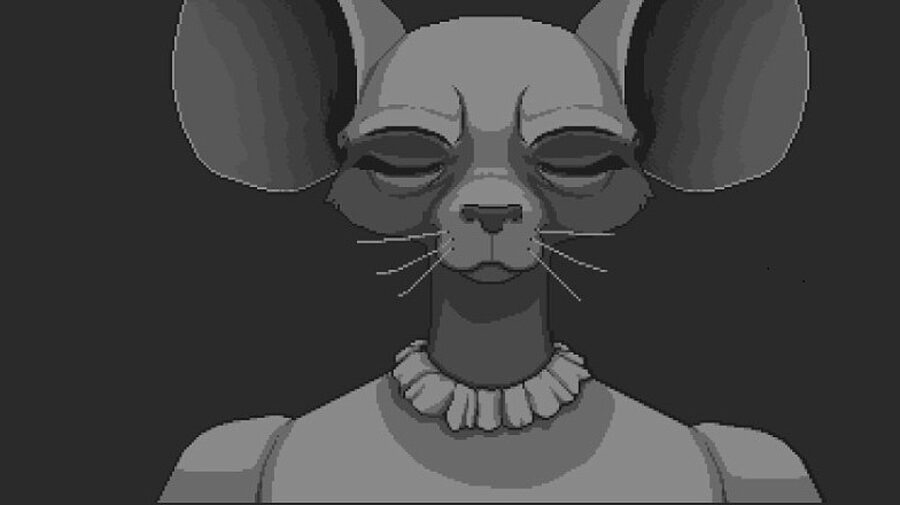It’s a gutsy game that makes you sit through a three-minute opening credits sequence of just a slow pan along a long road – a pixelated black and white road – and not let you skip it. Three minutes feels like an eternity to not do something in a game. But, unhurriedly, the names of the developers appear on the screen, and breathy folk music whispers in your ear. I’m hammering every button I can think of to get the game moving because normally games get moving by now, and who has time for this? But The Longest Road on Earth makes you make time. This is its pace. It walks, it waits, it queues. So, so do you. And that’s the point of the opening: to settle you down and prepare you for something quite different.
Curious things happen when you slow down. Unlatch the mind from whatever you have it attached to and it begins to wander, and wonder. Random thoughts start to occur. You may start to see stories in things. That’s what I think is happening here. Not only is the game about the silences in life, it’s deliberately creating silence so you can fill them with interpretations of what you think they’re about. What you think it, the game, is about. Because nothing here is declared. There’s no dialogue, no text, no overt declaration of what is going on. There are just animal-people going about their lives. What connects them, if anything? You decide.
This is the opening part of the game, after the credits. There’s a real delicacy to the way the game moves, a grace. It does a lot with very little.
Like I said, it’s a gutsy thing to do. Even little things like characters walking instead of running creates a jarring feeling. But I think they jar on purpose. We don’t run around all day do we? No, so why should they? They are not ninjas or people doing extraordinary things, as in many games. They are normal people doing normal things. They hang out washing, they walk to work, they ride the train. Actually, there’s a lot of riding the train. And while you’re on the train, there’s nothing to do but observe: to look at the lamp on the table, or to look at the people opposite you, faces pulled down by life. Is that why no one runs? Is that why the world has no colour in it? Incidentally, there is a wonderful moment when someone does run, unshackled by life, and it feels joyous.
These are the questions that bubble up, the ‘what’s going on?’s. What is the mouse lady’s story about at the beginning? She seems to be suddenly in an empty house, thinking about someone who’s no longer there, who has perhaps grown up and gone out into the world to find their own life. Now, she eats alone, and sits on the porch on her own. She seems lonely, she seems nostalgic for days gone by. Or is she?
And is the person she let go the one you walk around a metropolis (that is probably New York) with a toolbox, while looking for work? And why does he gaze at tuxedos in shop windows, and why does he always seem to gravitate towards pianos? Is he a pianist underneath all of that, dreaming of performing on the big stages?
And what of the two workers at the shipping company? Are they two sides of the same coin, one fortunate, and one not? Or have I got it all wrong? Am I simply seeing in these vignettes the kinds of stories that revolve around me in my life. Am I, in some way, seeing the things I see in life reflected back at me?
It’s a ponderous game. It’s a slow game, though it lasts only around two hours. And throughout it all, that folk music plays. It’s a striking soundtrack, and it reinforces the mood wonderfully, and I think in the lyrics you can find some of the strongest clues as to what the game is about. So what is it about? That, I think, should be up to you. What do you see?
Eurogamer.net
Source link
Related Post:
- The Longest Road On Earth Arrives May 27
- The Longest Road on Earth review – “Never has an empty mailbox brought so many feels” | Articles
- Procedural road trip adventure Road 96 gets August release date • Eurogamer.net
- Mario Golf: Super Rush Is Better When You Slow Down
- Road 96 Review – The Road Is My Home
- Procedurally generated road trip game Road 96 gets August release date, new trailer
- Blizzard aims to slow down Hearthstone with slew of nerfs coming tomorrow
- Nintendo’s Mobile RPG Dragalia Lost Will Soon Slow Down On New Content
- Kitaria Fables Quests Slow Down an Otherwise Full Game
- 9 Things You Should Do With Your PS5 (And 4 Things You Shouldn't)
